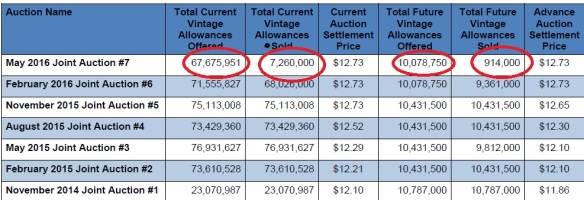
As I was preparing to teach my environmental law class yesterday, the California Air Resources Board released the quarterly carbon auction results from August 16, 2016. Similar to the May 2016 auction result, there is reason to be concerned about the demand for carbon credits, though the outcome appears to be better than May. For illustration, I cut out the chart from the CARB press release:

Less than 35% of the available 2016 vintage credits found buyers, and less than 10% of the future 2019 vintage credits (to be used in the future). This is better than last May, when less than 10% of all available for sale found buyers. Compare the August auction results to auction results for the past couple of years in the chart below from a CARB summary report:

The results show how weak demand is, even though things appear to have improved from May. Weak demand for the future vintages, i.e. credits that cannot be used until a future compliance year suggests uncertainty among buyers/participants in the carbon market about the market’s future. Under the current legislation, AB 32 (The Global Warming Solutions Act of 2006), there is only authority through 2020, by which California is supposed to reach its 1990 levels of carbon emissions. However, yesterday, the California Assembly passed S.B. 32, which would extend the carbon emission reduction mandate to 2030 and lower the target to 40% below 1990 levels.
A couple of observations about these developments. First, these auction results, especially the ones before May 2016 show how much the carbon market is worth and the dollars that are changing hands in a key area related to managing climate change and the environment. Of course, the global carbon market, especially with the many different financing instruments that are involved, is even bigger in dollar size. As somebody who teaches law students and is an observer of the environmental specialty in the legal industry (as part of my interest in helping students make careers as lawyers), however, it is surprising to me that we haven’t seen a greater resurgence of this specialty, yet.
Second, while California has been the undisputed forward-leaning leader in addressing climate change and developing a carbon market in the United States, these efforts will increasingly be affected by developments in the federal government and in the climate change treaties. While the US EPA has been pro-active on climate change under this Administration, a signature initiative, the Clean Power Plan, is currently on hold because of pending litigation. Similarly, international work under the climate change treaties has been going on for decades now. However, conclusion of the recent Paris Climate Agreement marked a significant positive shift in US cooperation in these agreements and will likely create new opportunities for California.
